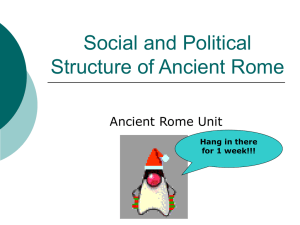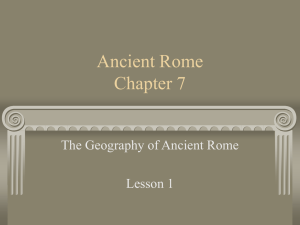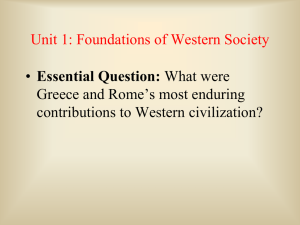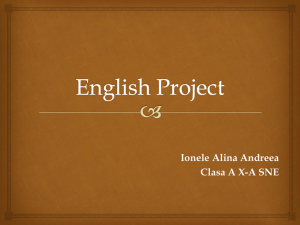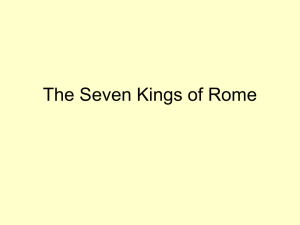C6.1 - The Foundations of Rome - World History and Honors History 9
advertisement
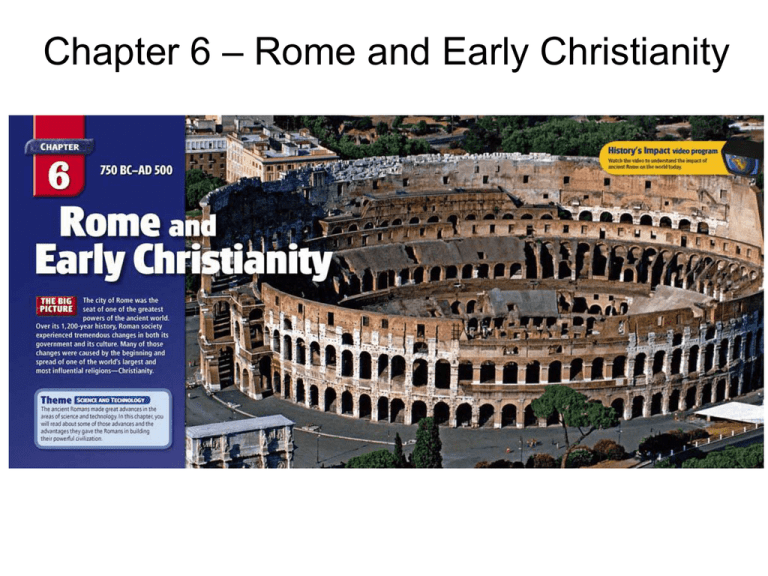
Chapter 6 – Rome and Early Christianity Chapter 6 – Rome and Early Christianity Section 1 – The Foundations of Rome A she-wolf suckles Romulus and Remus, founders of Rome Section 1 – The Foundations of Rome Main Idea From a small town on the banks of an Italian river, Rome grew to control the entire Mediterranean region. Reading Focus • Where and how did Roman civilization develop? • What led to Rome’s becoming a republic? • What were the major events in Rome’s expansion? I. Roman Civilization Develops The Seven Hills of Rome A. Italy’s Geography Italian Peninsula – situated in center of Med Sea. Rich soil, mild climate; Protected by mountains and sea B. The Founding of Rome 1000s BC - Latins settled along Tiber River 753 BC - united to form Rome; prospered through trade C. The Etruscans 700s B.C. – Etruscans from northern Italy ruled Rome II. Rome Becomes a Republic 509 BC – Romans overthrew the Etruscans, established a republic Tarquin and Lucretia by Titian (1571) Tarquin the Proud was the last king of Rome. The story of the Rape of Lucretia was a popular tale which explained the downfall of Tarquin and Etruscans. Overcome with desire, Tarquin's son, Sextus, raped Lucretia. She told her husband what had happened and urged him to avenge her. She then took her own life, sparking a rebellion that brought about the end of Etruscan rule and the beginning of the Roman Republic. A. Patricians and Plebeians Patricians - aristocrats who controlled society Plebeians - common people A. Patricians and Plebeians 494 BC - Invaders threatened, plebeians refused to fight; Patricians forced to expand plebeian rights The Plebian struggle to win more rights became known as the “Conflict of the Orders” A. Patricians and Plebeians New Plebeian rights: - elect officials (tribunes) - right to veto laws - Law of the Twelve Tables The Twelve Tables on display in the Roman Forum B. Republican Government Romans created an unwritten constitution and a three-part government 1. Senate 300 members, advised officials, controlled finances, handled foreign relations 2. Assemblies Citizens who voted on laws and elected officials 3. Magistrates Included consuls, censors, and praetors Consuls Censor Praetor a. Consuls Elected for one year: chief executives and army commanders b. Censors Recorded people’s wealth and residence; filled Senate vacancies c. Praetors Judges and acting consuls; became military commanders or governors after term ended B. Republican Government System of checks and balances prevented any part from becoming too powerful C. Life in the Republic The Forum was Rome’s political center; also shopping and social center C. Life in the Republic Forum was between Palatine (where wealthy lived) and Capitoline hills (had grandest temples) C. Life in the Republic Proud of agrarian roots; farming and landownership noblest ways to make money C. Life in the Republic Legend of Cincinnatus – called from farm, made dictator, saved Rome, and returned to his fields III. The Republic Expands As population grew, Rome fought wars to expand territory A. Military Might All land-owning male citizens aged 17 to 46 required to serve in army during times of war A. Military Might Army was a disciplined, well-trained force, organized into legions Roman Legion: 4500 to 6000 men A. Military Might Backbone of legion were the centurions, officers who commanded 100 men B. The Conquest of Italy By mid-200s BC, Rome controlled all the Italian Peninsula south of the Rubicon B. The Conquest of Italy Rome aided allies in Sicily, causing conflict with Carthage C. The Punic Wars Struggle for dominance resulted in three conflicts lasting 80 years – the Punic Wars C. The Punic Wars First Punic War began in 264 BC; lasted 23 years C. The Punic Wars Rome built a navy, used land warfare tactics at sea – rammed and boarded Carthaginian ships C. The Punic Wars After 23 years, Carthage sued for peace; were forced to pay reparations and give up Sicily C. The Punic Wars 218 BC - Second Punic War began; Hannibal assembled an army of infantry, cavalry, and elephants C. The Punic Wars Marched across Alps into Italy; spent 15 years raiding Italian countryside C. The Punic Wars Rome invaded Africa and threatened Carthage; Hannibal ordered home to defend the city C. The Punic Wars 202 BC - Scipio defeated Hannibal at the battle of Zama; Carthage lost its power Publius Cornelius Scipio Africanus (236 - 184 BC) Victory of the Roman Scipio Africanus over the Carthaginian Hannibal. It was the last and decisive battle of the Second Punic War C. The Punic Wars 149 -146 BC: Third Punic War - Rome declared war against, besieged, and then destroyed Carthage "The Sack of Carthage" D. The Conquest of Greece Macedonia, Persia, and Egypt fought constantly; Greeks became Rome’s ally D. The Conquest of Greece Macedonia, Persia defeated, made Roman provinces; Romans then annexed Greece Rome added Spain, Carthage, Macedonia and Greece, after the Punic and Macedonian Wars D. The Conquest of Greece Romans adopted elements of Greek culture, especially art, architecture, and religion Discus Thrower (Discobolus), Roman copy of Greek bronze by Myron (c. 485 - 425 BC) D. The Conquest of Greece By 133 BC, Rome was the supreme power in the Mediterranean world D. The Conquest of Greece Conquered peoples became subjects of Rome, not citizens or allies



